Oregon State Hospital cremains mix-up: 'Who's been sleeping with Grandpa all these years?'
Sandi Durham's most cherished memories of her grandmother are of riding the bus downtown to shop and have lunch at Meier & Frank, which opened in 1955 in Salem.
They repeated the outing most weekends until her grandmother suffered a series of strokes and eventually became a patient at the Oregon State Hospital.
Memories of visiting her grandmother at the hospital are just as vivid, although unpleasant and uncomfortable.
Durham was 10 at the time, and her grandmother often was restrained to the bed by leather wrist cuffs and unable to speak, making only grunting sounds.
Carrie Ethel Hardy was a patient at the state hospital for six years and 24 days, admitted because of changes in her personality and behavior after the strokes.
Unlike many patients at the time, her family visited often until Hardy died at the hospital in 1963 of bronchopneumonia. She was 71.
Also unlike many patients who died at the hospital, her family claimed her cremated remains. She was buried next to her husband at Belcrest Memorial Park — or so the family thought until recently.
An identification mix-up 60 years ago left the remains of someone else in her resting place at the south Salem cemetery.
"This has been quite a trip for us and quite emotional," Durham, who lives in Keizer, said. "I had to bury my grandmother all over again."
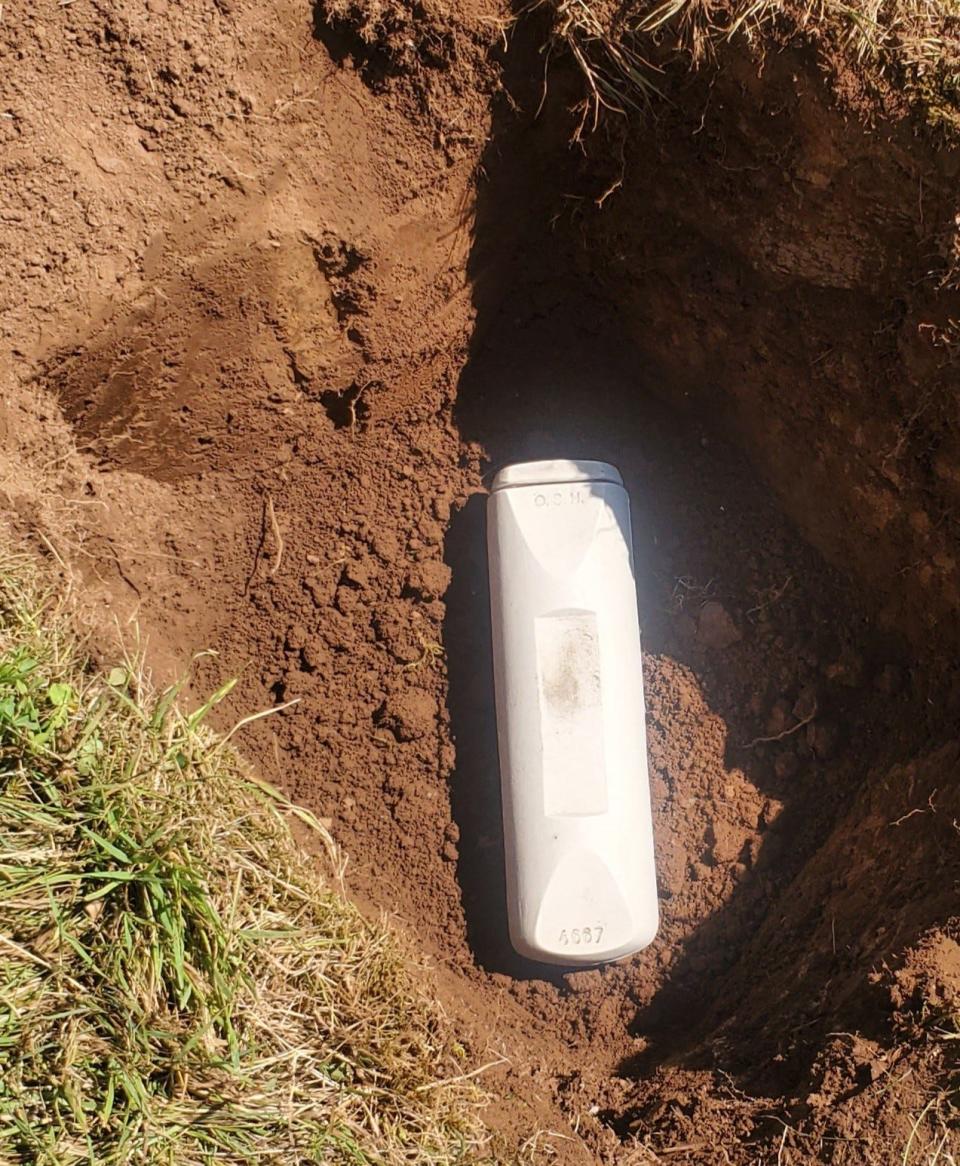
She and her family have so many unanswered questions. How could this have happened? Who have they been visiting graveside all these years? And could there have been other urn swaps by the state hospital?
Durham said a hospital official told her family this had never happened before. A spokeswoman told the Statesman Journal it is not something the hospital tracks, so she could not say if there had been other instances.
But the Statesman Journal knows of at least one other instance where a family unknowingly interred the wrong cremains received from the hospital. The error was revealed thanks to a list of unclaimed remains made public during the development of a memorial to honor the lost and forgotten at the hospital.
The same list revealed the unthinkable for Durham and her family when her nephew was doing genealogy research. Her grandmother was still in the custody of the state hospital and interred in the metal columbarium wall of the memorial, dedicated in 2014.
"Why didn't you bury Grandma next to Grandpa?" the nephew asked his family.
Remains moved again and again
The Oregon State Hospital Memorial was built to confront a dark history at the institution, originally named the Oregon State Insane Asylum.
Some patients, like Durham's grandmother, were not mentally ill. They may have experienced brain trauma or suffered from epilepsy or alcoholism, for example. The reason for admission in the file of one female patient, according to the state hospital website, was "too much marriage."
Once admitted, many patients lived there until death. The hospital had a cemetery in its early days, but in 1913 was directed by the Oregon Legislature to exhume all bodies and erect and maintain a crematory on the grounds.
The cremated remains were placed in copper canisters and stored in multiple locations on campus for decades.
In 1976, the hospital transferred the canisters to underground vaults around what previously had been a fishpond and called it the Memorial Circle. The urns were moved again in 2000 because of flooding and water damage. The copper cans showed signs of corrosion, and many of their paper labels were destroyed.
The cremains were then stored in a small, nondescript hospital building and in 2003, the unofficial caretaker allowed the Statesman Journal a peek inside. The newspaper reported more than 4,000 copper containers lined the narrow shelves, three deep in most places.
Retired Senate President Peter Courtney toured the site 16 months later, calling it a "room of lost souls" and vowing to return cremains to families and build a public memorial to honor the forgotten.
The memorial was dedicated on July 7, 2014, with a U-shaped columbarium wall enclosing a courtyard anchored by a small brick building that was once part of the hospital's original crematorium.
Video: Oregon State Hospital memorial dedication in 2014
The entire north wall of the building is a plexiglass window, revealing a kaleidoscope of now-empty copper cans on floor-to-ceiling earthquake-resistant shelves. Empty spots on the shelves signify remains reunified with family members.
The cremated remains were transferred from the copper cans into ceramic tube-like urns and placed inside the wall. Each niche has a circular plate engraved with a number, name, and birth and death years, if known.
The names are of people who died between 1913 and 1971 at the state hospital or other state institutions, primarily patients, and organized clockwise by year of death.
Near the end of the east wall is niche 4667.
Ethel Hardy.
1891 – 1963.
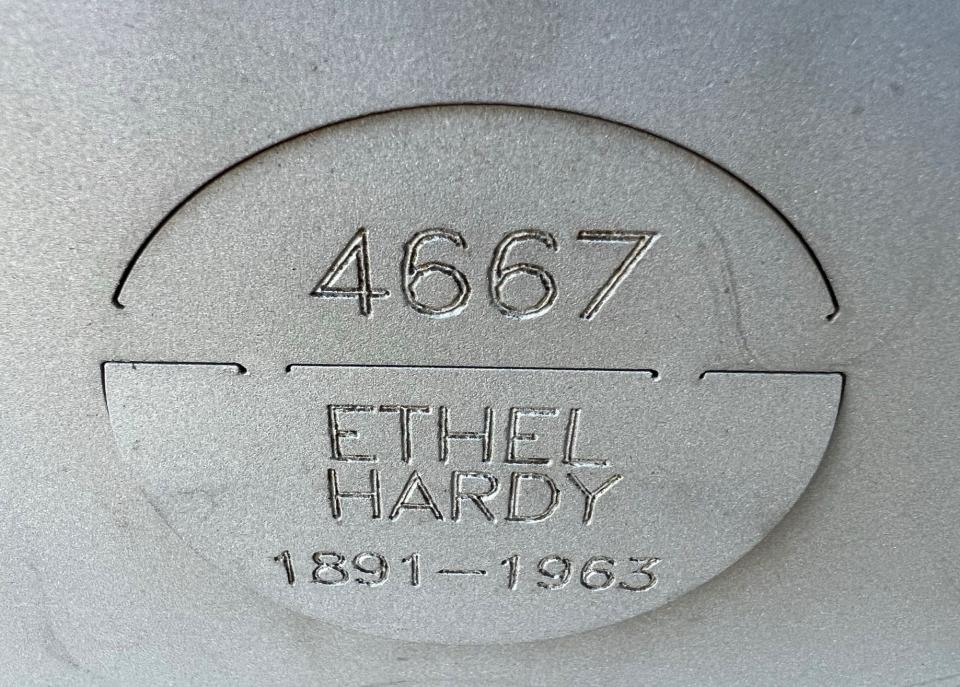
A life before admission
Her full name was Carrie Ethel Hardy, although hospital records and her death certificate list Ethel as her first name and no middle name. Her grandchildren knew her by another name, Eddie, pronounced Ee-dee.
She was born on Aug. 9, 1891, in Benton City, Missouri. She married Vance Hardy at age 15 and had her only child, Warren Hardy, at 16.
Warren was Durham's father.
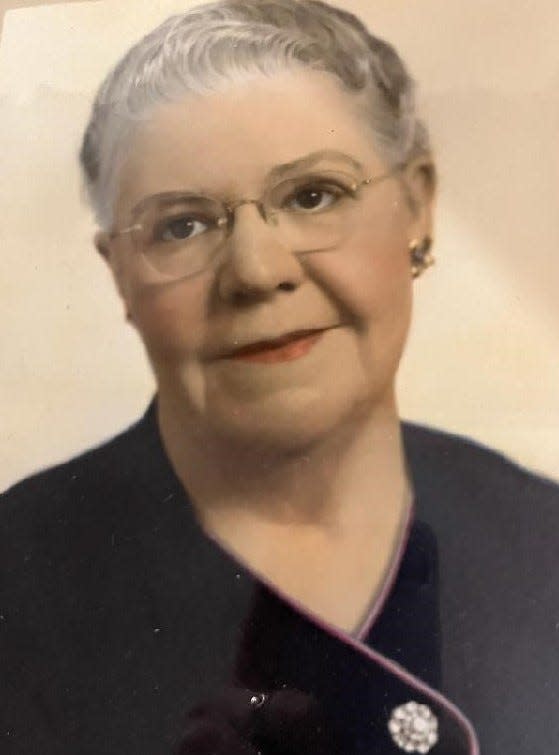
Ethel and Vance were married for 18 years before divorcing. She married his younger brother, Orville Hardy, about a year later. Durham and her brothers didn't know Orville was really their great uncle until reading a family questionnaire in her state hospital medical file. Ethel remained married to Orville until his death in April 1956.
She was admitted eight months later to the state hospital after a series of strokes. Her son described her as having a poor memory, stubborn disposition and bizarre behavior.
She was patient #15599, wearing a gray and white cotton print dress with red trim, nylon hose, garter and black house slippers with gold, red and blue figures when she arrived, according to hospital paperwork. The only other personal property she came with were her glasses and a ring.
The hospital was more of a custodial institution at the time. Many of its patients were housed there instead of in nursing homes. Ethel had briefly been in a nursing home before becoming increasingly difficult to care for.
State hospital notes described her as a "husky and noisy senile patient" and "very uncooperative and ornery." She tried to pinch and bite aides and nurses caring for her.
Ethel's son, his wife, and their three children, including Durham, visited almost weekly. Ethel was never aggressive toward them. Her medical records noted she appeared to recognize them and enjoy their visits, although she would forget they had been there minutes after they left.
Discovering where Ethel really was
Durham was 16 when her grandmother died at the state hospital in 1963. She remembers attending her burial at Belcrest Memorial Park.
No one had reason to question whether the copper urn delivered to the cemetery contained anyone other than Ethel's ashes.
The family may never have known if Durham's nephew had not come across Ethel's name online in the list of unclaimed cremains in 2019.
Durham went to the memorial wall to see for herself. Sure enough, she found Ethel Hardy etched on one of the round metal markers. She contacted the state hospital.
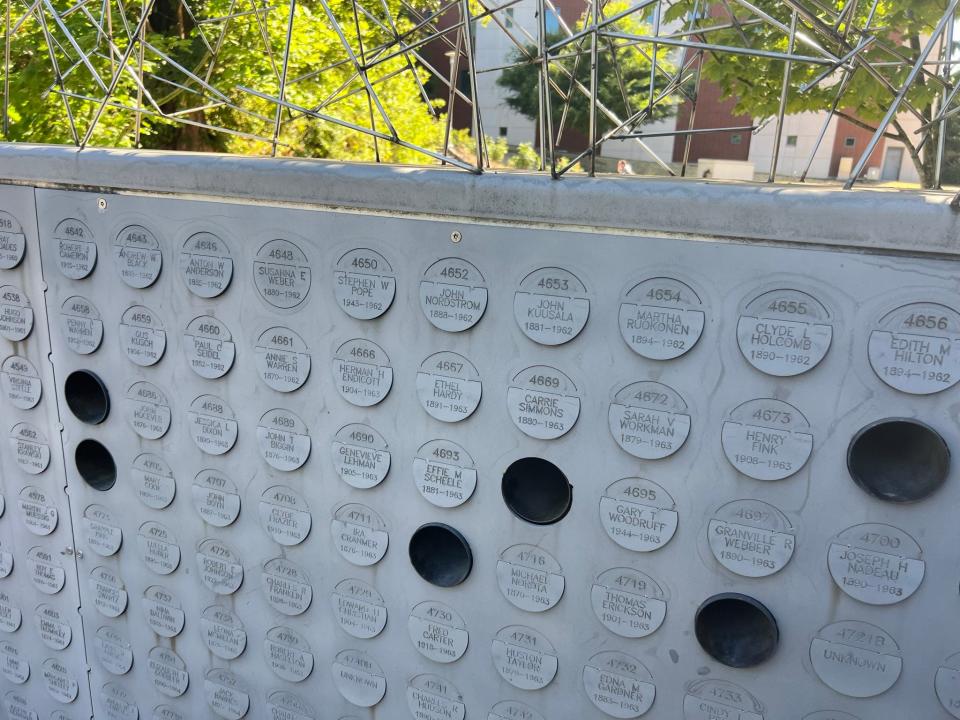
She shared with the Statesman Journal email conversations between her and Joni DeTrant, health information manager and records custodian. DeTrant emailed a copy of the cremations log entry, which showed the etched number matched Ethel's name. She also sent photographs of the original copper urn on Dec. 24, 2019.
Durham demanded the hospital pay for the disinterment and interment costs to bury Ethel next to her second husband. The hospital agreed.
An email DeTrant sent Feb. 24, 2020, indicated Ethel's urns were in her possession — the ceramic one containing her ashes and the empty copper one that previously held them.
Durham said she understood the state hospital would deliver the cremains to Belcrest, and assumed it had. The hospital claims Durham expressed a desire to pick them up in person.
Then COVID-19 intervened. Burial services were delayed.
At some point, between miscommunication and the pandemic, the hospital returned Ethel's remains to the memorial wall for safekeeping.
Nearly three years passed before Durham and her brother, Ed Hardy, could arrange for burial this summer. Their other brother Warren Hardy Jr. died in the meantime.
They reached out to Belcrest around Memorial Day to choose a date. They found out then the cemetery didn't have Ethel's cremated ashes.
Durham circled back in mid-June to the state hospital, which again opened niche 4667 on the memorial wall and pulled its ceramic tube out.
This time, Durham took her grandma home. Her brother was with her. He insisted they buckle up Grandma in the back seat, and they did.
On July 6 — 60 years, four months and 28 days after presumably laying her to rest — Ethel was buried in the cemetery.
Durham set the ceramic urn in the grave. Her brother tossed in the first shovel of dirt. Belcrest handled the rest.
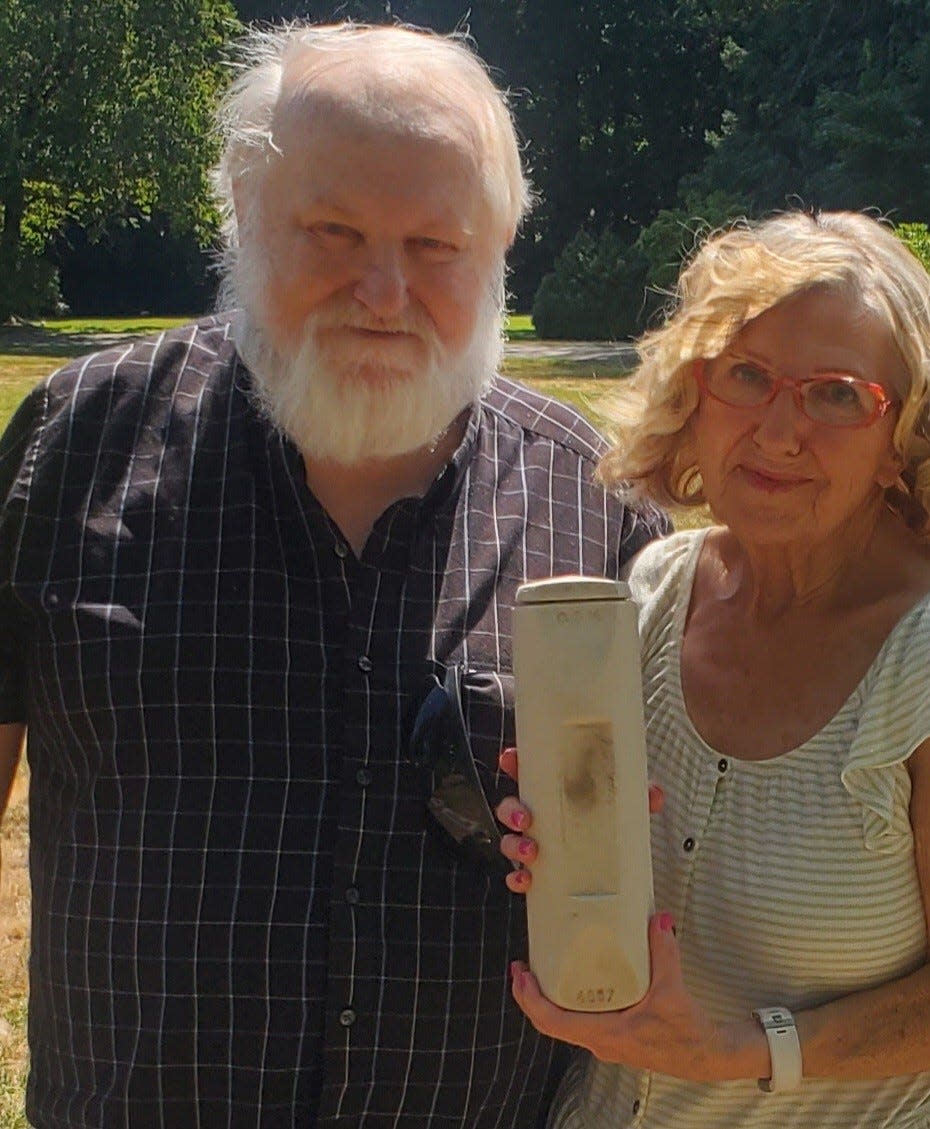
Identifying the other ashes
The cremated remains mistakenly buried in Ethel's plot were found encased in cement and dug up the same day.
Durham and her brother, joined by Ethel's great-great-granddaughter Justice Hakes, kept their fingers crossed there would be identifying marks on the long-buried urn. They decided beforehand they would return the remains to the grave if there were none.
Cemetery officials used a sledgehammer to chip away the cement, finding a copper canister covered in blue-green patina but still intact. There was no paper label, but the identification number etched on one end was legible.
It was 4295, not even close to Ethel's number.
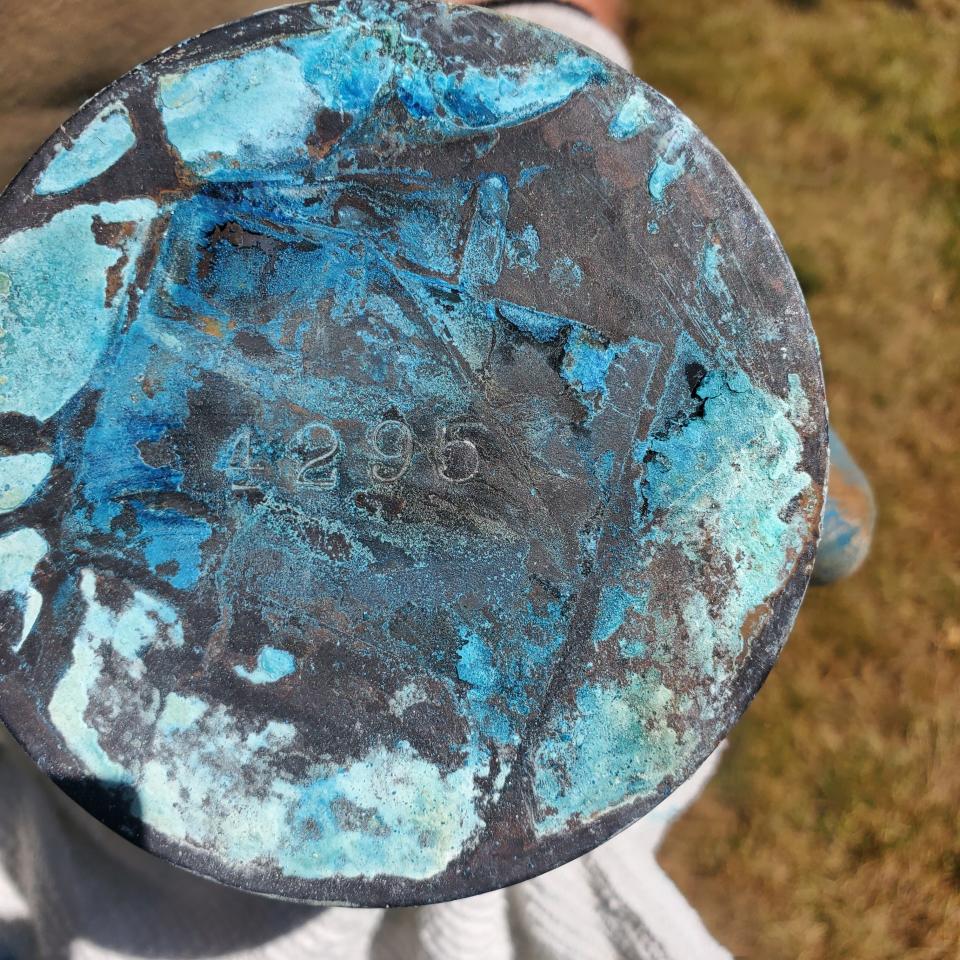
The copper urn bearing 4295 was placed in storage at Belcrest, where it remains. Cemetery officials told Ethel's family they would contact their legal team about how to proceed and have since had conversations with state hospital officials.
The state hospital confirmed it paid Belcrest $1,950 for the interment of Ethel and the potential interment of the other cremains.
Durham said she was thrilled to be able to find a number on the copper urn and called the state hospital to share the news. She hoped to hear back from someone and was disappointed she never did.
"I really want to find out about the person we have been visiting and leaving flowers for the past 60 years," she said. "I feel so connected to them."
Her brother was more direct in what he wanted to find out: "Who's been sleeping with Grandpa all these years?"
Other cremains identified
The Statesman Journal requested the identification of urn 4295, and the state hospital provided the answer Durham and her family were waiting for.
Hospital records identified the cremains as Alva Wallar.
By then, the hospital had asked volunteer genealogist Phyllis Zegers, who did much of the research for the memorial project, to try to track down living relatives.
Zegers, who is not an employee of the state hospital, said she sent nine letters to potential relatives without explanation of the mix-up 60 years ago or the current location of the cremains. The letters informed them they could claim the cremains through the state hospital.
Zegers told the Statesman Journal she heard back from one person who was grateful for the bio provided on Wallar but did not say whether he would claim the ashes.
"We are waiting to hear back from Mr. Wallar's family to see how they would like us to proceed," hospital spokeswoman Amber Shoebridge said.
Zegers estimates about 40% of families contacted are interested in claiming their loved one's cremains. In some cases, they never knew who the person was or that they died at the state hospital.
Her work has helped families unravel mysteries and correct family history.
Zegers knows this much about Alva Wallar: He was born on Oct. 18, 1897, in Polk County, Iowa. He worked as an auto mechanic in the mid-1910s and moved to Portland in the 1940s. On Nov. 8, 1956, he was admitted to the state hospital. He was there 20 months before dying of pneumonia in 1956 at age 60.
'You wonder how many people'
If no family member claims Waller's cremains, he cannot be added to the memorial wall. Sue McConville learned that the hard way when she and her siblings discovered a similar mix-up.
The cremains of her biological father, Thomas Randall, urn 4928, were thought to have been interred next to his parents in 1967 at a columbarium in Seattle.
But the family discovered after the memorial opened that his cremains were still at the hospital. The cremains of Carrie Moody, urn 4904, had been in his place for 50 years.
In that case, the numbers were relatively close. McConville imagines the two copper canisters on the same shelf and a hospital employee accidentally grabbing the wrong one.
Both mix-ups happened in the 1960s when the state hospital had its own morgue and crematorium. Belcrest records shared with the Hardy family note Ethel's cremains were delivered to the cemetery by a state hospital mortician.
"You wonder how many people this has happened to," Durham said.
When asked by the Statesman Journal how mistakes like this could have happened, Shoebridge said: "The hospital is not aware of the procedures that were in place 60 years ago."
No one stepped forward to claim Carrie Moody's remains. The hospital told McConville it was impossible to add a spot for her to the memorial. A year passed before McConville took matters into her own hands, seeking assistance from an attorney and the cemetery where the cremains had been.
A family member eventually signed over the rights to the cremains to McConville. She bought another niche at the columbarium for Moody.
"Those that we're finding today as errors have no memorial," McConville said. "I felt sorry her family rejected her again. I just wanted her to have some recognition."
2,325 remain unclaimed
More than 3,400 urns remained unclaimed upon completion of the memorial. Since 2014, the state hospital has reunited more than 1,000 cremains with families.
Once a year, the hospital removes the ashes of those whose relatives have requested them and holds a reunification ceremony. An additional 71 have been claimed and will be reunited with families on Sept. 26.
A hollow brass tube once replaced every urn removed. Designers described the growing array of brass as a symbol of the transparency of the project and the light shining through transcending the dark stigma of mental illness and institutionalization.
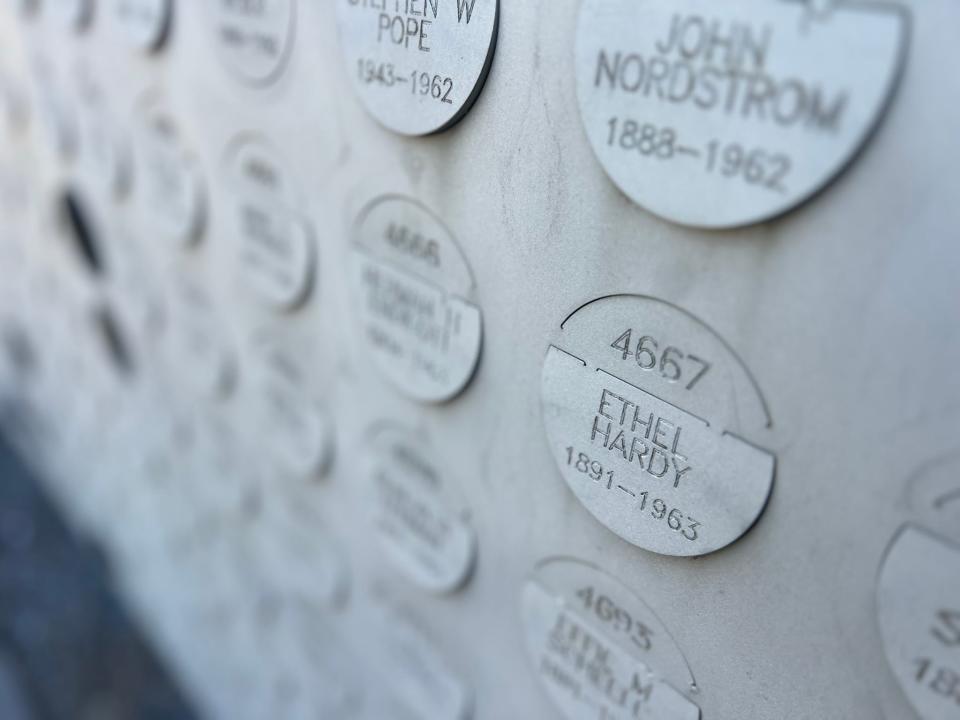
But the hospital no longer does that.
It does maintain an online searchable list of names, including dates of birth and death if known. The Oregon Legislature passed a law in 2007 allowing the disclosure of this information, protected by health privacy laws, to aid reunification.
The list is updated periodically, although Ethel Hardy still is included. Her name also still remains on the memorial wall, where the hospital said it will stay. The round metal plates are needed for structural reasons.
The original design of the memorial did not account for the number of cremated remains that would be claimed, so the removal of nameplates and the insertion of brass tubes created panel alignment issues.
Ethel is surrounded on the wall by others who died at the hospital around the same time in 1963: John Nordstrom, Effie Scheele, Herman Endicott and Carrie Simmons.
Zegers continues to loop back and re-research every name on the list, hoping all can be reunited with their families one day. She is hopeful because of the growing reach of the Internet.
After the ceremony next month, the number of unclaimed urns will be 2,325.
Families who can identify relatives on the list should email OSH.CREMAINS@odhsoha.oregon.gov or call the hospital's Health Information Department at 503-945-2976.
Capi Lynn is a senior reporter for the Statesman Journal. Send comments, questions and tips to her at clynn@statesmanjournal.com or 503-399-6710. Follow her work at StatesmanJournal.com.
This article originally appeared on Salem Statesman Journal: Oregon hospital delivers wrong cremated remains to cemetery

